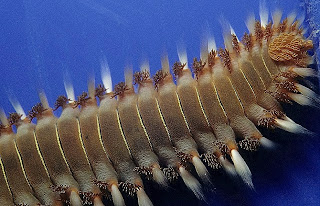 This was an experiment to see how changing the background changed the 'look' of the creature photographed. All three images on this page are of the same creature, but each photo uses a different background. (You can click on each of the photos for a larger view.)
This was an experiment to see how changing the background changed the 'look' of the creature photographed. All three images on this page are of the same creature, but each photo uses a different background. (You can click on each of the photos for a larger view.)The creature is a kind of Polychaete worm called a Bearded Fireworm (Hermodice carunculata). It's a very distant cousin of the earthworm (same Phylum). Those clumps of very fine hair-like bristles are called setae.
The setae look nice and fluffy in the photos, but they are not decorative. They are the Fireworm's defense against predators (and divers?). When something touches the venomous setae, they break off very easily and stick in the skin of whatever has disturbed them. The name "Fireworm" comes from the very nasty burning sensation caused by the venom in the setae.
[Note: Handling these guys can be very tricky and is not recommended, even while wearing gloves. The setae will break off and stay lodged in the glove fabric, only to be transferred to your skin later on.]
The first photo shows a Bearded Fireworm on a natural background, just as we found it. This particular one was photographed in the Mediterranean Sea at Konnos Bay, Cyprus, but we have seen this species in many other places.
 They crawl around on sandy and rocky bottoms at shallow depths, looking sort of like big caterpillars or centipedes. We've also seen them in seagrass beds, hurrying to and fro, searching for a meal.
They crawl around on sandy and rocky bottoms at shallow depths, looking sort of like big caterpillars or centipedes. We've also seen them in seagrass beds, hurrying to and fro, searching for a meal.The largest Fireworms we've seen have been about six inches (15 cm) long, but we understand that they do grow bigger. Most often we have seen them as individuals, but occasionally we have seen groups of them devouring sea urchins, a rather creepy sight.
Can you guess what the blue background is in the second photo? Believe it or not, it's Jerry's dive fin! On the spur of the moment we decided to scoop the Fireworm onto the fin to see what it would look like on a blue background. If you look closely, you'll even see scratches on the fin.
 Then we noticed a red encrusting sponge nearby. We dropped the Fireworm from the fin onto the sponge. He started to crawl away, but not before I was able to photograph him on the red background. I think I like the red background the best.
Then we noticed a red encrusting sponge nearby. We dropped the Fireworm from the fin onto the sponge. He started to crawl away, but not before I was able to photograph him on the red background. I think I like the red background the best.I do like the color blue, of course, but blue plastic hardly is a 'natural' background, so the red sponge just works better, visually. The contrast shows off the Fireworm to good advantage.
Moving a creature to a nicer, prettier background is an old trick in nature photography -- on land as well as underwater. I haven't done it too often, but when I have, I always try to return the photo subject to its natural setting.
I'm not at all sure that a Bearded Fireworm would voluntarily crawl onto this kind of sponge, so before we left, we moved the creature back to where we initially found it on some algae-covered rocks. It's only fair.

BNSullivan.jpg)

BNSullivan.jpg)
BNSullivan.jpg)
BNSullivan.jpg)
BNSullivan.jpg)

BNSullivan.jpg)


Stunning photographs, beautifully constructed website - thank you for sharing your work.
ReplyDeleteFantastic image Bobbie, your site is like exploring another world, I love it.
ReplyDeleteI agree, Bobbie, the red background really shows him off best - makes him look "fluffier". Hard to believe he is like a cactus - but some cactus look pretty soft too.
ReplyDeleteHe looks like he has plants or seaweed growing at the base of the setae - are they for camouflage?
Excellent post and photos!
Kathy
Hi Julie. Welcome to The Right Blue. Thank you for the compliments.
ReplyDeleteBernie, spending time underwater is like going to another world. I think that's why we've kept going back all these years.
Kathy, your cactus analogy is a good one. And those little plant-like structures that you spotted sprouting out of the base of the setae? They are gills, as far as I know.
Bobbie
Awesome creature!
ReplyDeleteIs there a lightbox option for blogspot? Would fit your blog! :)
Hi Thomas - Hmmm, a lightbox feature is an interesting idea. Maybe I should think about that for the static pages that go with this blog. Thanks for mentioning that.
ReplyDeleteBobbie
While you are at it switch to wordpress ;)
ReplyDeleteCame back to stumble this post. Deserverd it!
Wow, thanks for the Stumble, Thomas. :-D
ReplyDeleteI followed your comment on my blog back to here.
ReplyDeleteVery cool blog!
There's a lot of stuff here, I'll have to dig around when I get time.
Hi Forest Rat. Yes, I visited your blog a day or so ago and liked it very much. Looks like we both have a keen interest in nature subjects. Hope you'll come back again.
ReplyDeleteBobbie
It looks like some alien bug.
ReplyDeleteThe more I read of your blog the more I like it. You've got great informative posts about the sea. Good stuff. Keep it up. All the best, Chris.
ReplyDelete@ Dawn (AntiB) - You are right, it really does look like a bug -- like a large centipede with fuzzy edges.
ReplyDelete@ Chris - Welcome back and thank you very much. We appreciate your comments.
Bobbie & Jerry